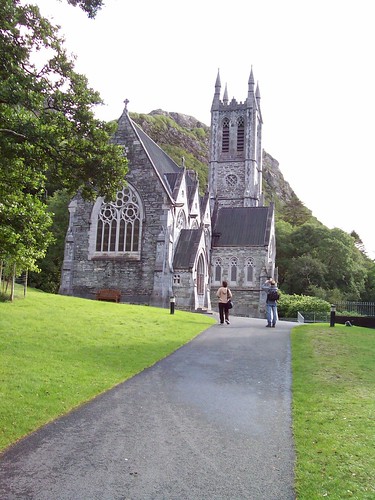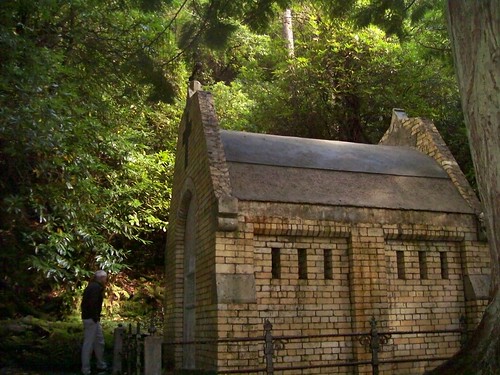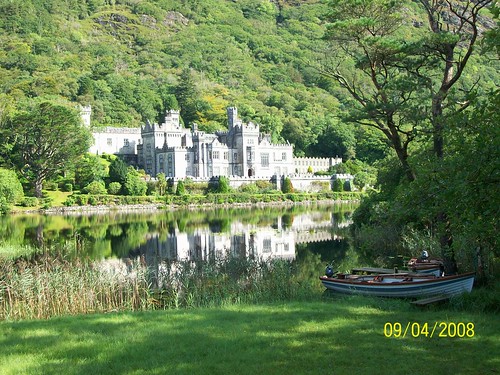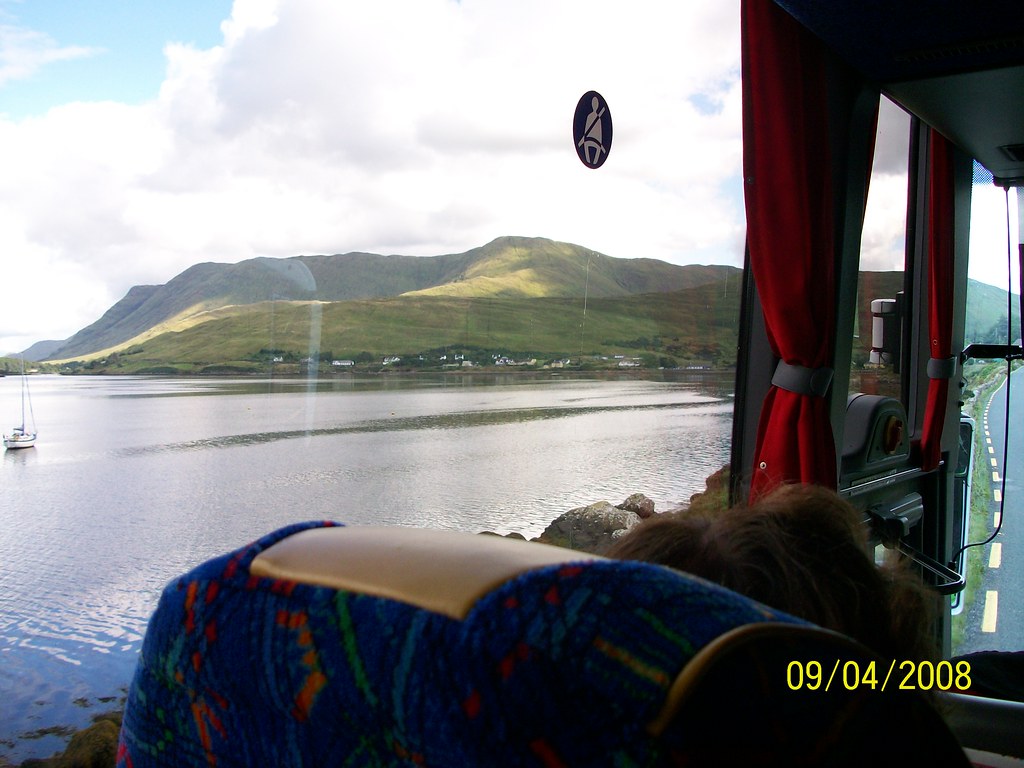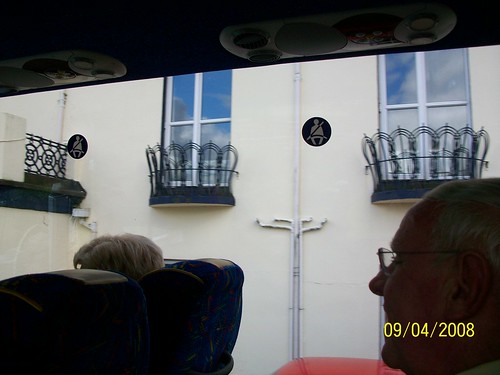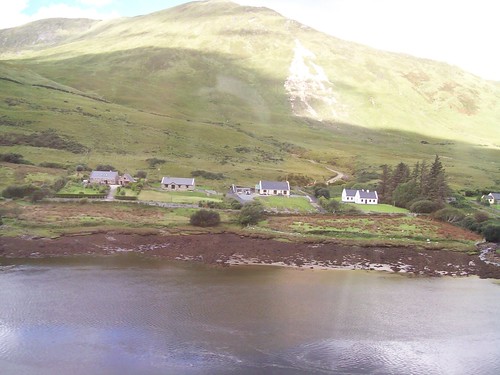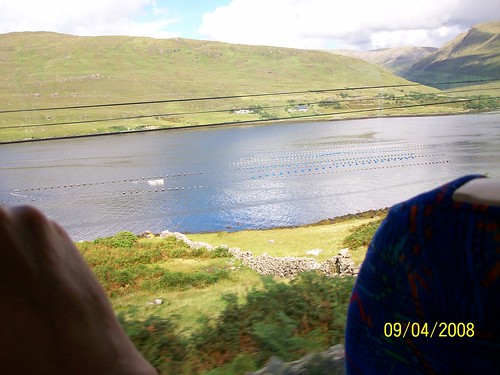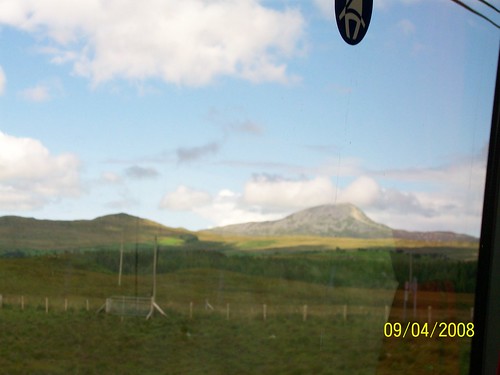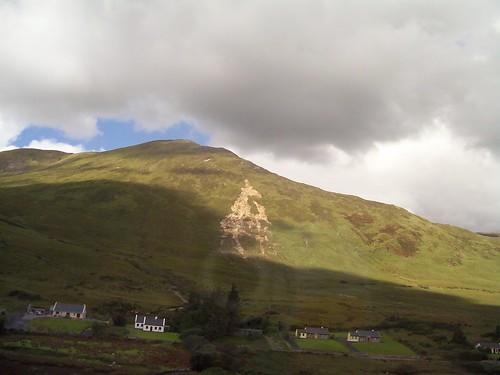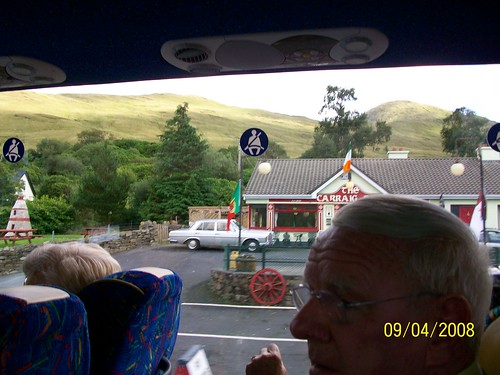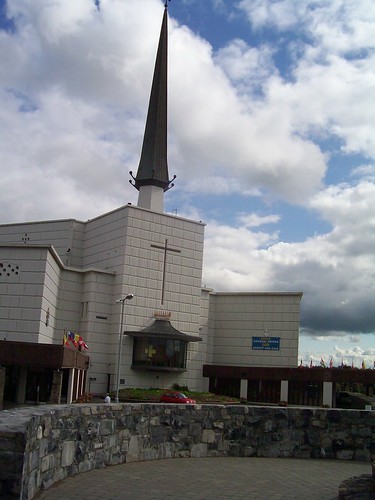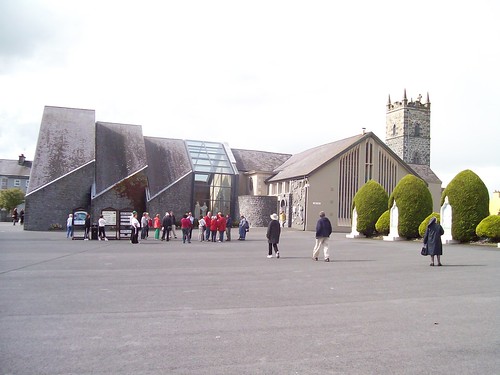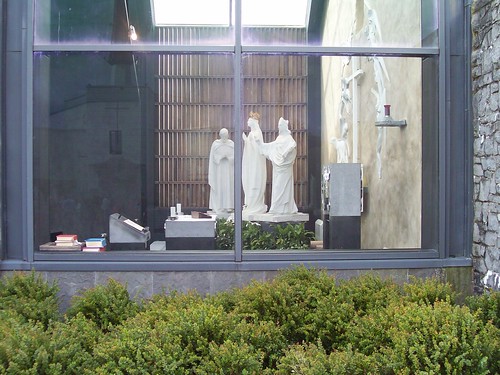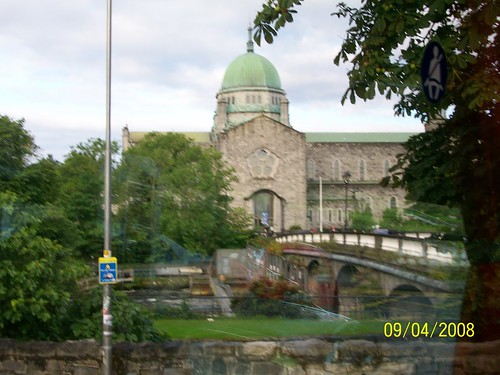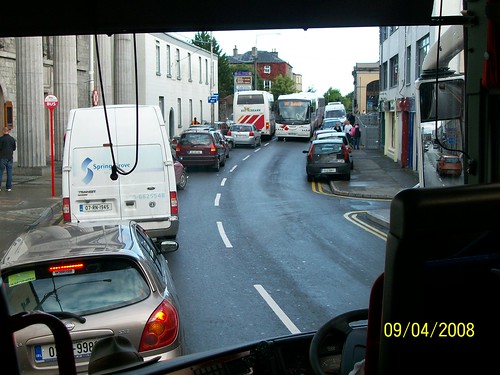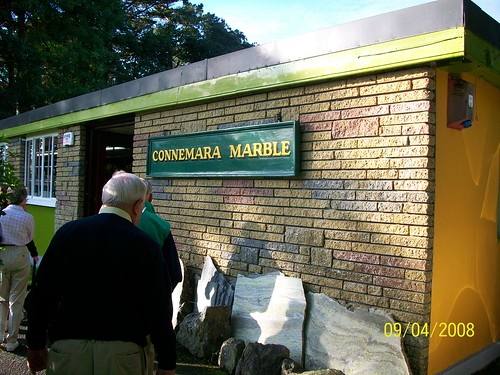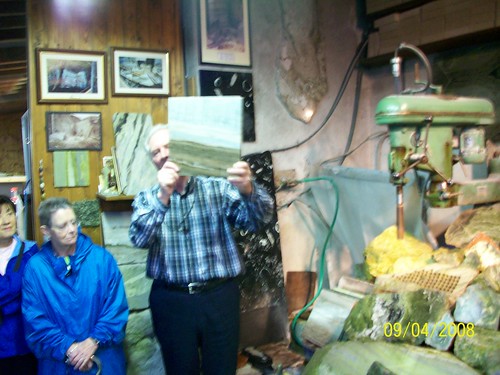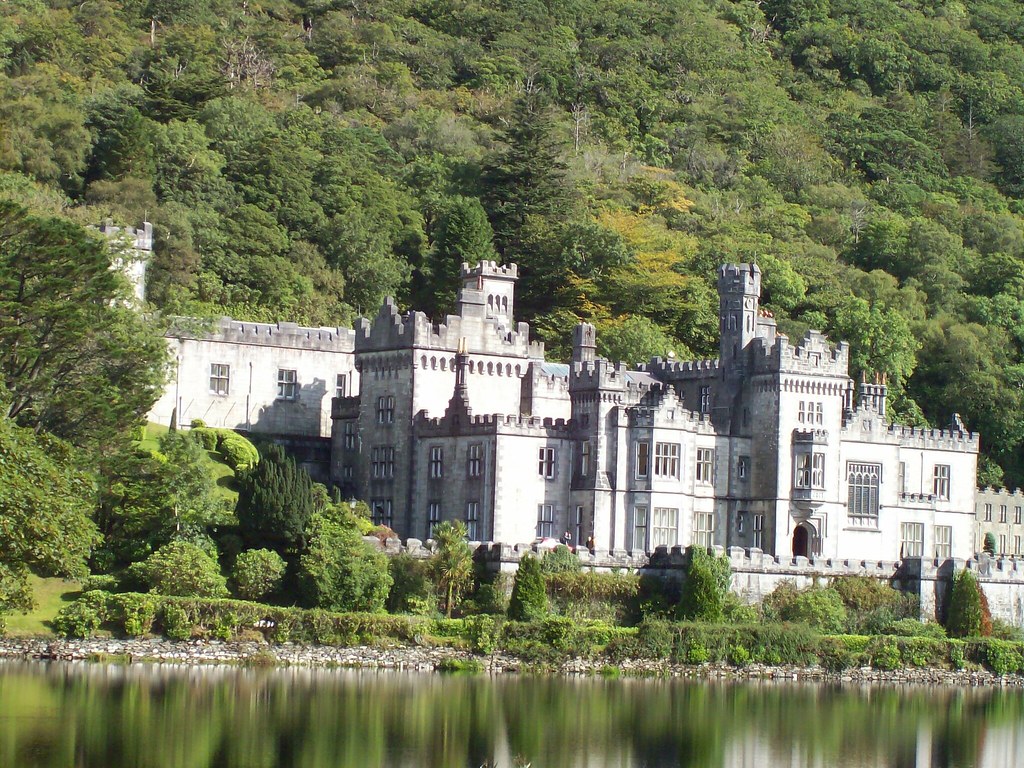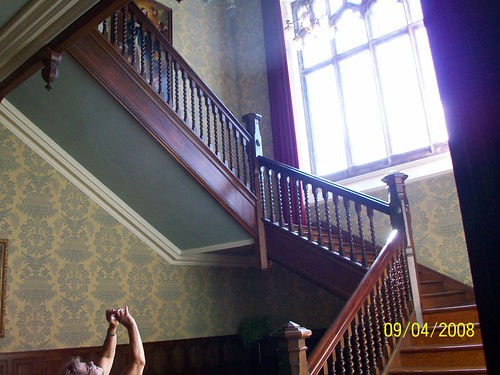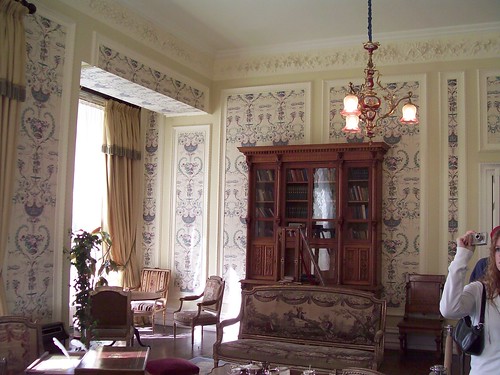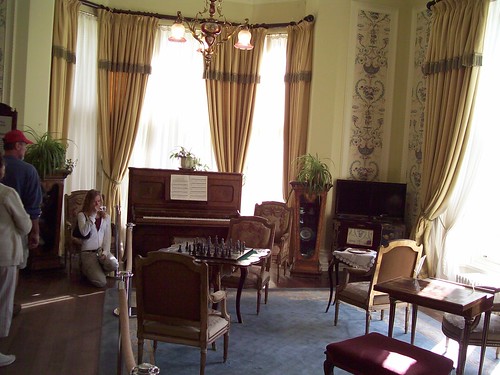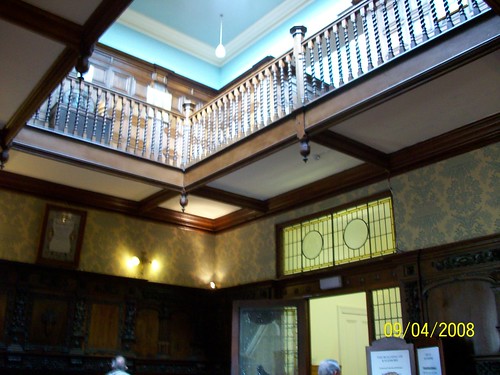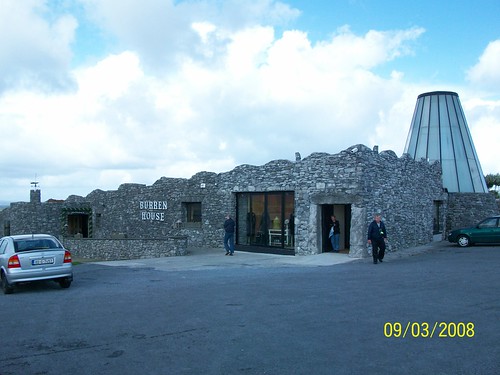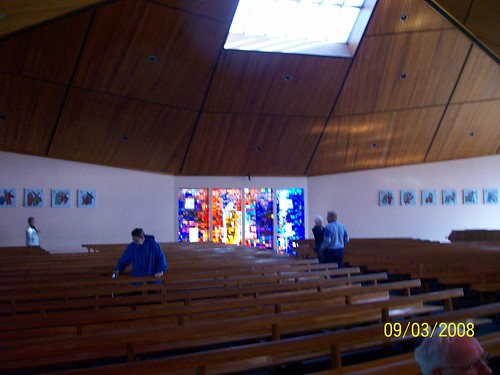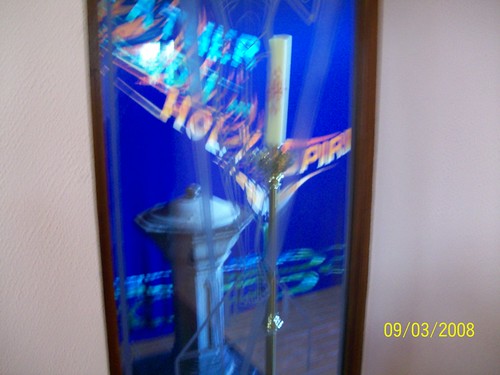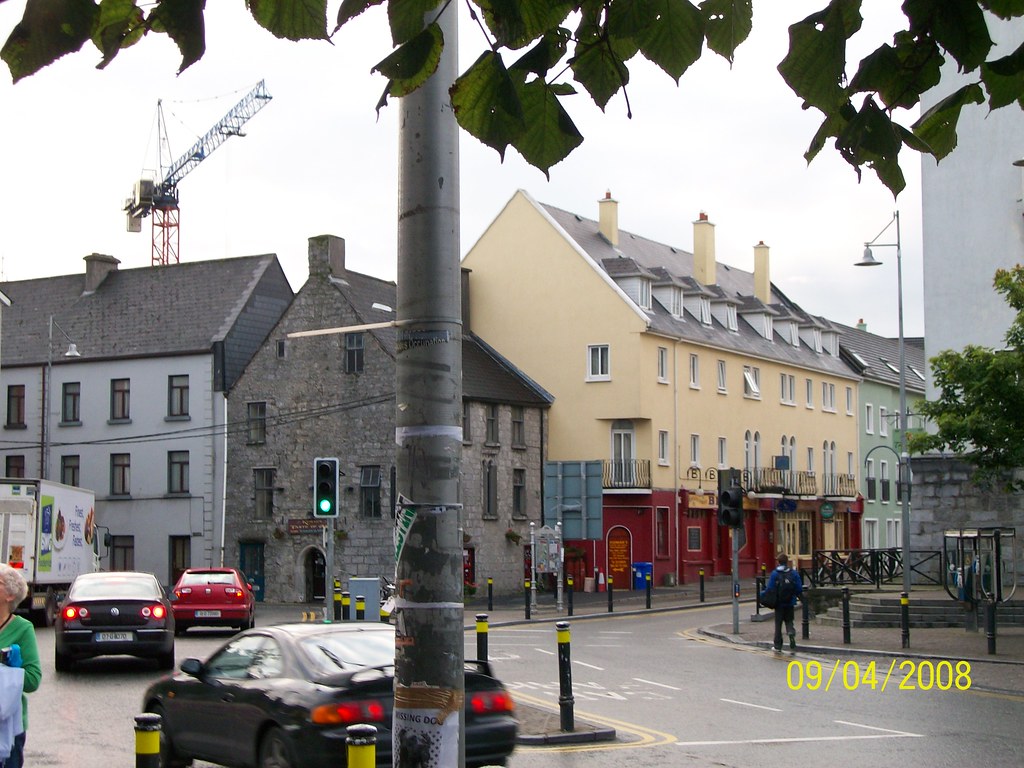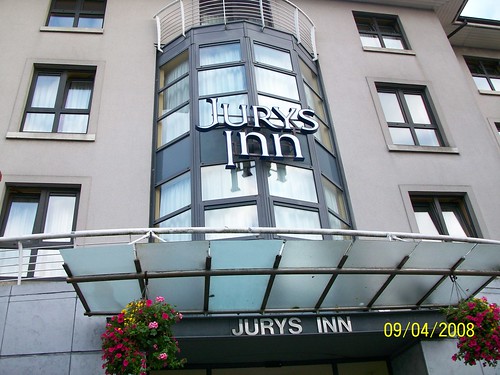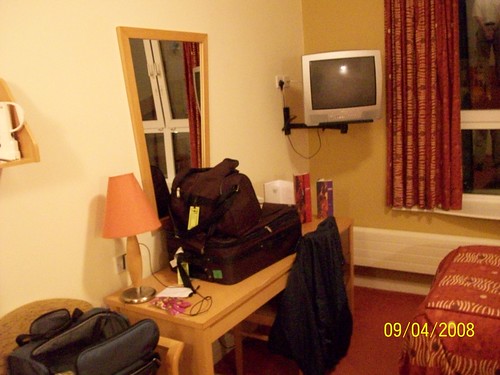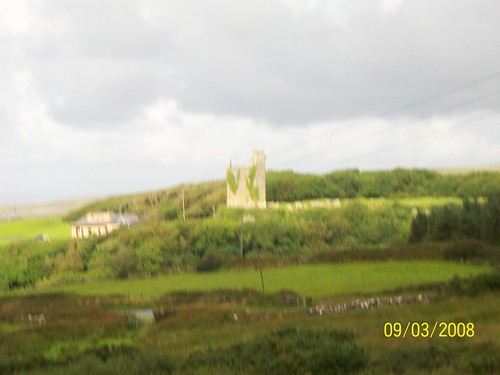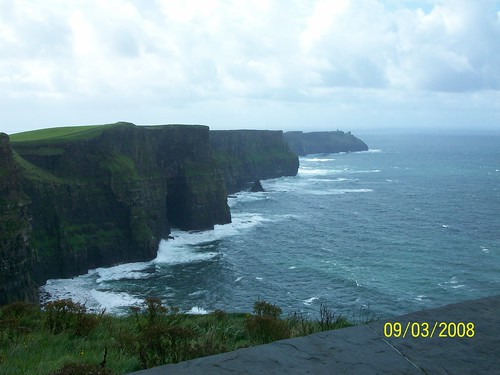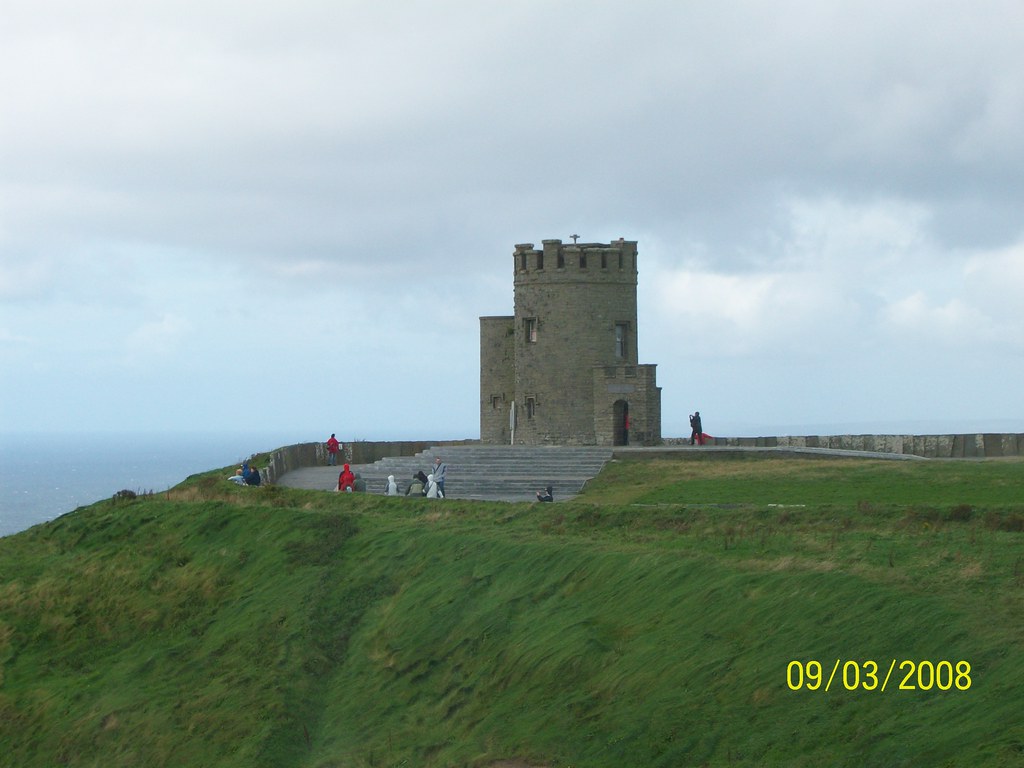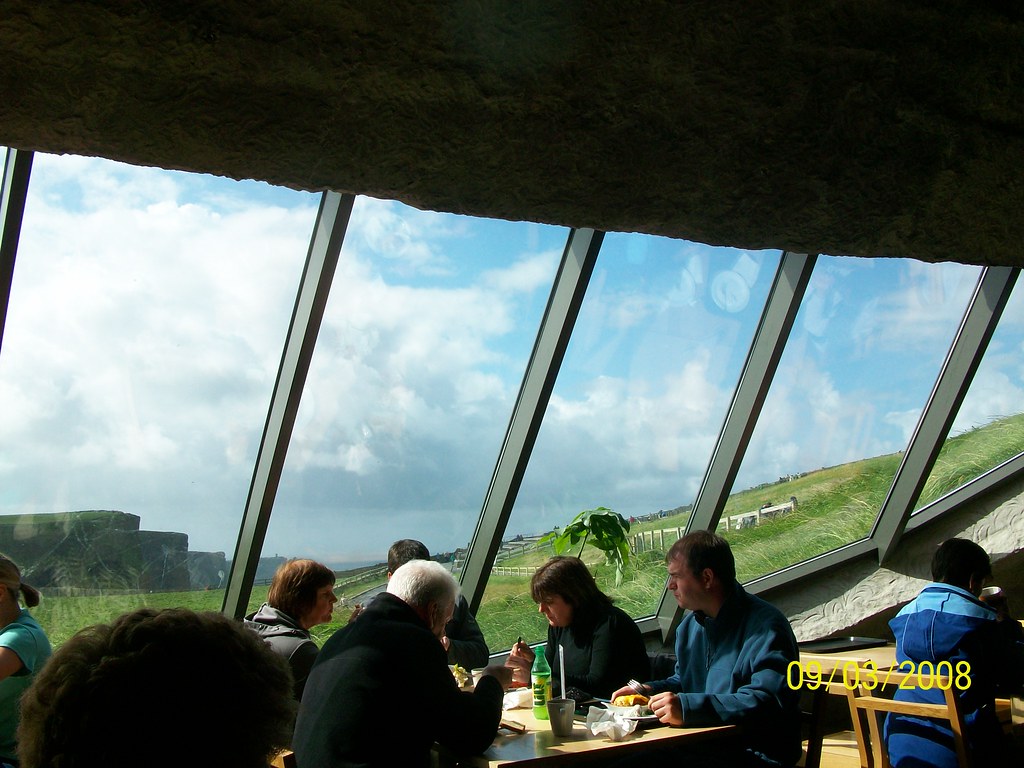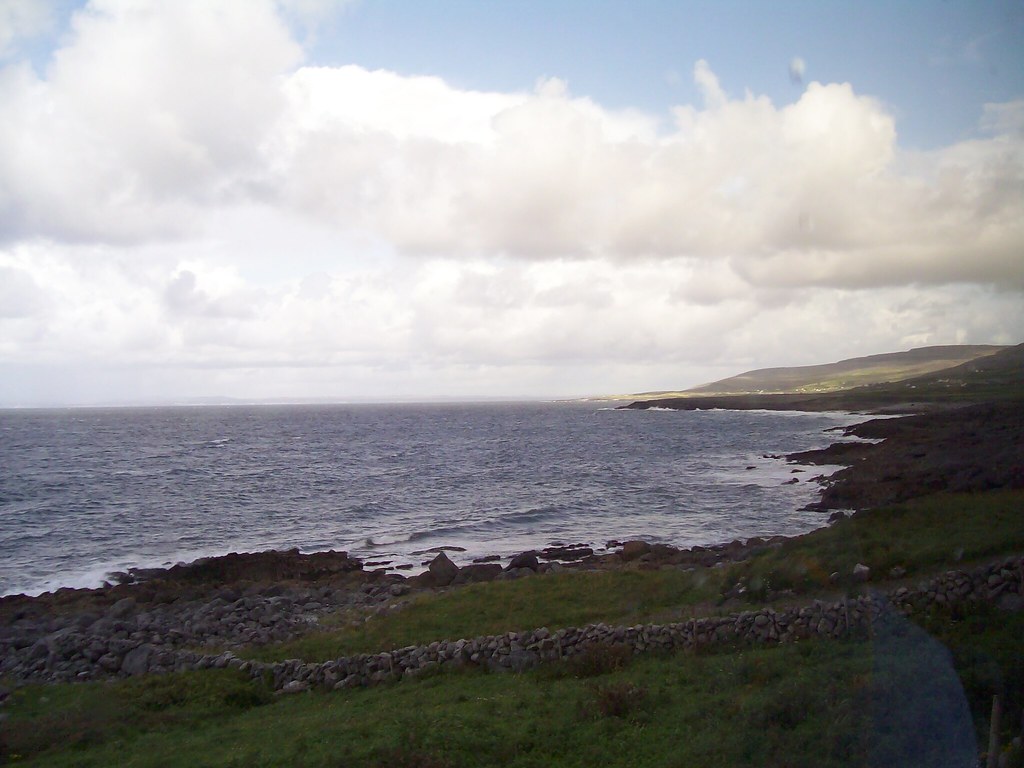The Emerald Shores of Ireland - Part 6
A trip journal by David Bowers
9/2/08-9/11/08
Part 6
We continued along the lakeside trail to visit, as the sign says the "Newly Restored Gothic Church" This church is just far enough back the trail were you start to doubt yourself. Am I going the right way? Will we be able to get there in time? I pulled out my park guide which had a park map in it, but the map was clearly not drawn to scale. We knew Jerry had mentioned the church as a must see, so we pressed on. We did mention that if you didn't have time constraints that the walk back to the church through the woods and alongside the lake would be a wonderful meditation walk. We then came to a clearing in the woods, and in that clearing was a chapel sized church of gothic architecture. Every time I think the sencery in Ireland can't get better, it does. Here away from any traffic noise, with the trees even cutting off the lake or any view outside the area stands what appears to be a mini Gothic style church complete with church graveyard out front. We take a walk alongside the exterior of the church gazing at the beauty, then go inside. Inside the church gets its beauty not from the works of master artisans of paint and sculpture but rather from the simple architectural beauty. Lots of leaded glass windows make the room light and airy and the decorative use of marble in the columns and the simple furniture in the space give off a simple uncluttered look that is instantly classic and timeless.
We left the church, which according to the sign was built in 1877, and its recent restoration paid for out of the European Regional Development Fund, another example of how Ireland is benefiting from joining the European Union is that it seems like there are restoration/preservation projects going on all over of its historical sites. Anyway the sign said the church was built by the Mitchell family, whose mausoleum can be seen just east of the church. We continue alongside the trail, which after the church turns from pavement to gravel and continue back to take a peek at the mausoleum. The mausoleum itself is a rather simple brown brick structure with the entryway sealed shut with bricks. We noted this was the last site noted on the park map, so we started the now very long walk back along the lakeside trail, stopping to get photographs of the sites coming from the other direction. We also noted a very attractive waterfall and some unique looking flowers that were surrounded by a metal guard. We returned to the area where the bus stop to the gardens is located. We had already used up our hour for touring and were heading into the second hour and still needed to get lunch. I pulled out my park guide and noted busses run every 10 minutes and it's a 5 minute ride. I also noted the bus wasn't here, and did a pessimistic calculation, a worst case scenario that if we just missed the bus to the gardens, and then we arrive back at the other bus stop just having missed it again, that's half an hour to be given up just for transportation let alone actually seeing the sights. We decide to pass up on seeing the Victorian gardens. We do seem to run into most of the others at the restroom building located inside the gated area. They were very small restrooms leading to a line, but at least we knew where a good deal of the tour group was. Also in the area back by the restroom was a building labeled Video Cabin. They had a video playing in there and we could hear the sound while waiting our turn and were able to deduce the video wasn't about the abbey itself.
We then headed through the exit turnstiles and headed back out along the lakeside trail till we came back around to the visitors center and followed the signs to the restaurant. There was a short line to get into the restaurant. We thought, "Hey, if it's a buffet, all we have to do is pay, grab a plate and load up" Should be very fast. We would soon learn that when Jerry says buffet, he means cafeteria, albeit one where you may be fixing your own plate, but its still billed cafeteria style. I did to a double take when I saw beer in the beverage case, at a a religious site. I grabbed a Coke from the beverage case and headed to the main line area where we both settled on Chicken Kiev. I ordered Chicken Kiev and wasn't quite prepared for the litany of questions. "What kind of potato do you want?" I opted for the boiled potatoes "What kind of vegetable do you want?" I went with the carrots, "What kind of sauce do you want?" It seems here instead of the sauce being inside the Chicken Kiev along with the vegetables, they sit the vegetable filler on the plate, then a plain breaded chicken breast, then cover it with your choice of sauce. "What kind of bread do you want?" Give me the brown bread. When that was done I had a very appetizing looking lunch. We headed to the cashier station and were taken aback when our meals totaled up in the €13 range, each. We started a new table and soon were joined by others in our tour group. Most of them had gone for lighter fare like soup, salads, or sandwiches, and it was clear we were causing lunch table envy for the rather large generous size meals we were having. Some pleasant lunch table conversation ensued and we were soon down to just about 15 minutes left. While dining I had noticed that they had tray return racks by the exit doors and they were pretty regular with replacing them, even before it was needed. At the conclusion of our meal, which was serve don real plates and had non-plastic silverware, I picked up my tray and carried it to the tray return rack. I was intercepted just before inserting my tray with a very pleasant "Thanks a lot! You weren't expected to do that."
We took our last few minutes at the site to peruse its rather large and diverse gift shop which contained way more than religious goods or gifts from the abbey. That said, nothing really caught our eye in the gift shop so we got out of that one empty handed. We returned to the bridge that returns to the parking lot and notices the simple rowboats docked alongside the lake which apparently can be rented from a booth near the bus parking area. We also noted that if you look just right you can see both the castle and the church at the same time. We tried to get this view on camera, but I'm afraid we weren't successful. We returned to our bus in time to sort of laugh at the teenagers getting off the bus next to us some dressed in attention getting "Hey, look at me" clothing.
We next had a long drive to our next site. The good news is we had some more of that gorgeous landscape to drive past. We were going through farmland and at times we noted the sheep were not afraid at all of the tour bus driving past. Jerry quipped, "Oh, those sheep know us, they probably know my name, where I am going, and if we are ahead or behind schedule" We came close to some sheep and we could clearly see painted splotches on their sides. We asked about this. Now I must say, my Mom took a similar tour of Ireland about 10 years ago, and she heard an entirely different answer than I did, so I'll give both, you be the judge. Mom was told tht those painted splotches are for health reasons, when a sheep is given particular vaccinations it is painted with a color coded splotch to record what medicines the sheep has received. I was told the painted splotches come from the use of common area grazing where several areas farmers send their sheep to graze in a common area, the splotches identify whose sheep are whose. Father replies back with the verse "I know my sheep, and they know me"
We also passed some interesting things such as a wind turbine for alternate source energy, as well as farmers bundling up peat as an alternate fuel source. Jerry mentioned that peat is used for heating fuel, and there is a big business in bundling up peat and selling it. Jerry, however looked saddened when we passed what looked like it once was a great field that looks like it had been strip mined. He mentioned this work used to be performed by hand, now they bring in big machines to do it, but what is bad is when they don't make any effort at trying to restore the landscape to the way it used to look.
Jerry mentioned that caution must be taken if you were to visit the wetlands where peat is found as peat tends to suck anything into it pretty quickly, similar to quicksand. He did mention that if you find yourself sinking into the peat, and there is nobody around to rescue you, you could take consolation in the fact you would be very well preserved. Right at at about this time, we pass another bus that has pulled over and its passengers are starting to walk into the wetlands. Jerry asks "Should we stop a bit and see if they sink into the peat?" We continue forwards.
Along our way we would occasionally see cyclist or backpackers walking along the roadside, and Jerry mentioned that those are still very popular ways of seeing the Irish countryside, he also mentioned that it used to be farmers and other property owners were pretty laid back and as long as the backpackers didn't do any harm to their land, they had no problems with them exploring it. That all came to an end when the courts started finding landowners liable if a backpacker comes on to their land, uninvited mind you, and then hurts themselves, even if its purely their own fault. This has caused the landowners to become less welcoming of the hikers, but it has also caused some farmers to make the most of it, and start leading paid farm tours. Jerry told an anecdote of such a group he had once that had scheduled a tour of an Irish farm on their tour. He said it was a very fun tour of the farm, then when the farmer led them out to the middle of a big field, he asked everybody to lie on the ground on their backs. Being good sports, they obliged their host who then said "Now you are seeing my farm the way my sheep do!"
We then came through a village whose name I forget, but it was buildtaround a lake and the thing I remember is that Jerry told us an urban legend about a hotel on the main street. It seems that on one floor, in one section, the owner installed crown shaped balcony railings, this soon gave way to the legend that "The Queen has stayed at this hotel, and those crowns mark the room she stayed in!" He said of course this is patently false because in Irish society, important diplomats, even visiting ones stay in castles, as I might have mentioned earlier, but for the right price you too can spend the night in an Irish castle, or at least rent a room in one. Jerry then threwa jab at President Bush by saying that he realizes its common for a diplomat to bring a security team, staff, family and so forth with them, so when you entertain a diplomat you may have a few hundred people to look after, but when Bush came, the number of staff and security team members reach into the thousands.
The next site we sawfrom a distance was Coragh Patrick, or "Patrick's Mountain". Church history teaches that this is supposedly where St. Patrick fasted for 40 days and 40 nights and drove all the snakes out of Ireland. As such it has become a popular pilgrimage site, particularly on the last Sunday in July when as many as 30,000 may arrive. Jerry mentioned that the pilgrimage is quite exhausting as it can take 3 hours to climb up the mountain, and its not like there is a trail up to the top, the climb is up bare rock on uneven and steep hillside, which gets steeper as you near the top. Up top there has been a chapel erected for prayers, and then they climb back down which can take another 2 to 3 hours. In short a pilgrimage visit to Croagh Patrick would be an all day commitment, and he noted the local road system doesn't do a very good job of handling it. Jerry said that is the modern way of doing the pilgrimage, then there are those who do it the traditional way, and that is barefoot. Yes jagged rocks, gravel, uneven hillside, all barefooted. Some time it where they start in the middle of the night so that they arrive at the summit at daybreak. Yes, in order to do the pilgrimage right there are a series of prayer stations along the way and a set ritual of prayers and activities that must be performed at each one. Jerry noted you can see how the top of the mountain looks like there is a wide path, but it really doesn't that area has been worn down by the constant chain of pilgrims making the climb. He also noted that, as with many religious traditions this one too, predates Christianity as it was popular in pre-Christian times as a fertility pilgrimage. Jerry did note an anecdote where Ireland has used the snakes out of Ireland story when it comes to land disputes. "Scientist have found no snakes on that island correct? "Correct" "Well since St. Patrick drove the snakes out f Ireland and there are no snakes on that island, it must be part of Ireland!" He also talked briefly about the celtic cross, how we see it with a round circle overlaying the cross. One reason is stated that the structure needed the circular braces for support of the crossbeam. The other states that it is a fusion between pagan and Christian symbols.
After passing Coragh Patrick we came as close to Northern Ireland as we would get on this tour. For the most part Jerry tried to either ignore, change the subject or employ another diversion whenever anybody asked about Northern Ireland. I noted this is what my guidebook says that most polite Irishmen will do if you bring up the subject, followed by the disclaimer that a polite tourist shouldn't even bring it up since opinion varies widely and the wounds are still raw with some. It also notes that when trying to employ humor in Ireland, that Northern Ireland jokes are strictly taboo, particularly if you aren't from Ireland. It liked it to telling Civil War jokes over in the United States. Anyway, see I was also going for a diversion, but sometime later in the trip, when as you may have guessed there were some on the tour that didn't get the hints that it wasn't a topic he wanted to discuss, kept bringing it up, Jerry finally said quite firmly "Ah, so you've heard about our little disagreement have you…" Then after letting that drift off while finding a gentler tact, he simply said it's a sad thing, and that it boils down to basically a minority of the citizens of Ireland who thought "You know, England isn't so bad" so they came up with a compromise of having 6 of Irelands 32 counties stay part of the UK. They have their own parliament, but it does cause problems. Jerry said he will, if asked, include Northern Ireland destinations on tours but it causes a host of problems. Chief amongst them is that they still use the British pound, which means everybody, including him has to do some currency exchange stops on both border crossings, and that they are also on the British phone system, and that he has managed to ring up some pretty frightening long distance bills when he has to stay there overnight on a tour. He also mentioned that their citizens are fiercely patriotic to England, and like to decorate just about anything in the Red, White, and Blue of the Union Jack. So without really saying anything except maybe his own feelings, he got it out, and that was the last we heard on that topic.
Our next destination would be Knock Shrine, and since we were just passing through more countryside, Father decided that since it is a Marian shrine after all it wouldn't be a bad idea to say a rosary as a group as we approached the shrine. Luckily he had warned us of this at the get together party, so I was suitably equipped. After the rosary we were approaching Knock. Jerry mentioned that they laughed when Knock decided it wanted to build its own international airport, then they built it and it sat for a few years being used for non-aviation purposes, but now it has grown to be a popular airport for those coming to Knock from Europe.
We made our way to the turn off the main roadway to the road to Knock Shrine when our progress was halted by a beer truck stopped in our lane, and a solid line of cars coming the other way in the other lane. Jerry got out of the bus and took the situation in his own hands by walking up to the next intersection and diverting that opposing traffic onto a side street so we could get through. Yep, that's why he gets paid the big bucks. On the way out to Knock he gave us the history. The church used to be just a regular church in Knock until one night an apparition appears on the outside of the back wall. The apparition consisted of Mary, Joseph, John the Baptist and Jesus Christ, and occurred back in 1879. Since then Knock has turned into a big Marian Shrine. The old church still stands and is still in use, but has been supplemented by a large basilica. In other developments due to weather and vandalism, the back wall of the church started disappearing as people wanted a souvenir from the site. In order to protect the back wall from the elements and further damage an "Apparition Chapel" was built. It was announced this would also be the day's Mass stop, so we would have about 15 minutes before Mass then about 45 minutes after Mass to look around. We arrived at the gates where I noted a neat double gate arm, it seems the lower one that would stop all traffic is up, so private cars can enter unimpeded, however the upper gate arm was down, blocking tour busses. I also noted their gate arms lower down into big metal V's on each side to make it harder to run them. John started talking to the nice people at Knock Shrine over the intercom and we were close enough to the front to realize the gate people were giving John some lip about "It's almost 4, you realize we close for the day at 6, right?". Well, eventually they get that all sorted out and we pull into the parking lot.
We start our way up the hillside from the parking area up to the shrine, first stopping off at the comfort facilities then coming up into a big plaza. To our left is the newer basilica, very large modern looking building. Across the front of it was a long row of international flags, but my own flag was not represented. To our right is the older church, and stuck on the back of the church is the apparition chapel. We approached the apparition chapel and built into its side is a large picture window so you can gaze upon the back wall of the church even if the chapel is closed or full. The window also gives a great view of a series of statues that have been erected in the area to give a representation of what the vision looked like. Also in the area on the exterior wall is a large sculpture depicting a rosary.

